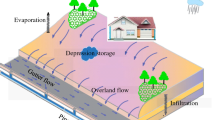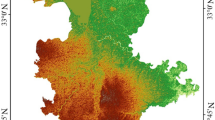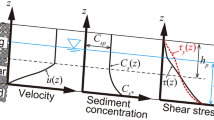Abstract
Farm dikes are of crucial importance for the flood defense system of a floodplain domain in the Lower Yellow River, with devastating losses caused by failure of dikes in record. Detailed investigations are therefore urgently required of dike-break induced flood inundation processes over the floodplain domain. In this study, a laboratory model was designed to reflect the different topographical characteristics of the channel-floodplain system, and a series of laboratory experiments were conducted to investigate the flood inundation processes over the floodplain domain before and after a sudden break of a segment of farm dike. Key water level hydrographs were measured at several points to illustrate the hydrodynamic characteristics of dike-break induced flooding. Furthermore, a two-dimensional (2D) hydrodynamic model with the solution of finite volume method was also developed to reproduce the flood inundation processes and investigate the influences of different bed roughness coefficients in the floodplain domain. Results from the measurements and the model predictions show that: (i) the dike-break induced flood wave developed from an asymmetric ellipse at the breach site, and then rapidly propagated toward the downstream floodplain domain after the impingement against the side wall due to a large transverse bed slope. The floodplain domain downstream of the breach site was the most vulnerable zone during a sudden dike-break induced flood event; (ii) the model predictions were in close agreement with the measured results, with the Nash–Sutcliffe efficiency values of water level close to 1.0 at most measuring points distributed in the channel and floodplain domains. The highest root mean square error value of water level at the measuring point was smaller than one tenth of the mean water level; and (iii) the flood propagation time and peak velocity in the floodplain domain were obviously influenced by different bed roughness coefficients. When the comprehensive roughness coefficient increased from 0.015 to 0.045 under the incoming discharge of 38 L/s, the flood propagation time extended by at least 8.0 s and the peak velocity decreased by at least 50% at the measuring points in the floodplain domain. Therefore, it is necessary to determine a suitable value for the comprehensive floodplain roughness coefficient when modeling the dike-break floods.











Similar content being viewed by others
References
Bellos CV, Soulis V, Sakkas JG (1992) Experimental investigation of two-dimensional dam-break induced flows. J Hydraul Res 30(1):47–63
Bomers A, Schielen RMJ, Hulscher SJMH (2019) Consequences of dike breaches and dike overflow in a bifurcating river system. Nat Hazards 97:309–334
Chinnarasri C, Tingsanchali T, Weesakul S et al (2003) Flow patterns and damage of dike overtopping. Int J Sediment Res 18(4):301–309
Danka J, Zhang LM (2015) Dike failure mechanisms and breaching parameters. J Geotech Geoenviron Eng 141(9):04015039
Ferguson RI (2021) Roughness calibration to improve flow predictions in coarse-bed streams. Water Resour Res 57(6):e2021WR029979
Gregoretti C, Maltauro A, Lanzoni S (2010) Laboratory experiments on the failure of coarse homogeneous sediment natural dams on a sloping bed. J Hydraul Eng-ASCE 136(11):868–879
Huai WX, Yang L, Wang WJ et al (2019) Predicting the vertical low suspended sediment concentration in vegetated flow using a random displacement model. J Hydrol 578:124101
Lauber G, Hager WH (1998) Experiments to dambreak wave: horizontal channel. J Hydraul Res 36(3):291–307
Liang L, Ni JR, Borthwick AGL et al (2002) Simulation of dike-break processes in the Yellow River. Sci China (Series E) 45(6):606–619
Moghadam MF (2006) Effects of land slope and flow depth on retarding flow in non-submerged vegetated lands. J Agron 5:536–540
Nagy L, Tόth S (2005) WP6: monitoring and case study, detailed technical report on the collection and analysis of dike breach data with regards to the process and location factors. Impact Project
Özer IE, van Damme M, Jonkman SN (2020) Towards an international levee performance database (ILPD) and its use for macro-scale analysis of levee breaches and failures. Water 12(1):119
Recking A, Frey P, Paquier A et al (2008) Feedback between bed load transport and flow resistance in gravel and cobble bed rivers. Water Resour Res 44(5):WO5412
Roger S, Dewals BJ, Erpicum S et al (2009) Experimental and numerical investigations of dike-break induced flows. J Hydraul Res 47(3):349–359
Schmitz V, Erpicum S, Abderrezzak KEK et al (2021) Overtopping-induced failure of non-cohesive homogeneous fluvial dikes: effect of dike geometry on breach discharge and widening. Water Res Res 57(7):WR029660
Schmocker L, Hager WH (2012) Plane dike-breach due to overtopping: effects of sediment, dike height and discharge. J Hydraul Res 50(6):576–586
Stone BM, Shen HT (2002) Hydraulic resistance of flow in channels with cylindrical roughness. J Hydraul Eng 128(5):500–506
Sun J, Liu LW, Lin BL et al (2017) Processes of dike-break induced flows: a combined experimental and numerical model study. Int J Sediment Res 32(4):465–471
Sun YH, Cheng SP, Zhang Q et al (2021) Research on flood risk assessment of floodplains from Huayuankou to Aishan section in the Lower Yellow River. Acta Sci Nat Univ Pekin 57(3):575–586 (in Chinese)
Viero DP, D’Alpaos A, Carniello L et al (2013) Mathematical modeling of flooding due to river bank failure. Adv Water Resour 59:82–94
Vorogushyn S, Merz B, Lindenschmidt KE et al (2010) A new methodology for flood hazard assessment considering dike breaches. Water Resour Res 46:W08541
Vosoughi F, Rakhshandehroo G, Nikoo MR et al (2020) Experimental study and numerical verification of silted-up dam break. J Hydrol 590:125267
Ward PJ, Jongman B, Aerts JCJH et al (2017) A global framework for future costs and benefits of river-flood protection in urban areas. Nat Clim Chang 7(9):642–646
Wood A, Wang KH (2015) Modeling dam-break flows in channels with 90 degree bend using an alternating-direction implicit based curvilinear hydrodynamic solver. Comput Fluids 114:254–264
Wu WM, Wang SSY (1999) Movable bed roughness in alluvial rivers. J Hydraul Eng 125(12):1309–1312
Wu WM, Jiang EH, Wang SSY (2004) Depth-averaged 2-D calculation of flow and sediment transport in the Lower Yellow River. Int J River Basin Manag 2(1):51–59
Wurbs RA (1987) Dam-breach flood wave models. J Hydraul Eng ASCE 113(1):29–46
Xia JQ, Lin BL, Falconer RA et al (2010a) Modelling dam-break flows over mobile beds using a 2D coupled approach. Adv Water Resour 33(2):171–183
Xia JQ, Falconer RA, Lin BL et al (2010b) Modelling flood routing on initially dry beds with the refined treatment of wetting and drying. Int J River Basin Manag 8(3–4):225–243
Xia JQ, Falconer RA, Wang YJ et al (2014) New criterion for the stability of a human body in floodwaters. J Hydraul Res 52(1):93–104
Xue Y, Xu WL, Luo SJ et al (2011) Experimental study of dam-break flow in cascade reservoirs with steep bottom slope. J Hydrodyn 23(4):491–497
Yang ZH, Li D, Huai WX et al (2019) A new method to estimate flow conveyance in a compound channel with vegetated floodplains based on energy balance. J Hydrol 575:921–929
Zhang W, Zhou JZ, Liu Y et al (2016) Emergency evacuation planning against dike-break flood: a GIS-based DSS for flood detention basin of Jingjiang in central China. Nat Hazards 81:1283–1301
Funding
This study was supported by the National Natural Science Foundation of China (Grant Nos. 51725902; 41890823); the Royal Academy of Engineering through the Urban Flooding Research Policy Impact Programme (Grant No. UUFRIP\100031); and the Newton Advanced Fellowships from the NSFC and the UK Royal Society (Grant Nos. 52061130219; NAF\R1\201156).
Author information
Authors and Affiliations
Corresponding author
Ethics declarations
Conflict of interest
The authors have no relevant financial or non-financial interests to disclose.
Additional information
Publisher's Note
Springer Nature remains neutral with regard to jurisdictional claims in published maps and institutional affiliations.
Rights and permissions
Springer Nature or its licensor (e.g. a society or other partner) holds exclusive rights to this article under a publishing agreement with the author(s) or other rightsholder(s); author self-archiving of the accepted manuscript version of this article is solely governed by the terms of such publishing agreement and applicable law.
About this article
Cite this article
Xia, J., Cheng, Y., Zhou, M. et al. Experimental and numerical model studies of dike-break induced flood processes over a typical floodplain domain. Nat Hazards 116, 1843–1861 (2023). https://doi.org/10.1007/s11069-022-05744-7
Received:
Accepted:
Published:
Issue Date:
DOI: https://doi.org/10.1007/s11069-022-05744-7




